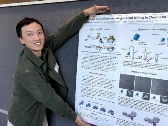Weifeng Lu
NHEJ in the context of chromatin
Trainee 2023/2024

Weifeng is a 3rd year IBiS student in the He lab. He received his B.S. in Biological Sciences from University of California, Davis, and an MS in Quantitative Biology from Northwestern University.
Research
Double strand breaks (DSBs) are one of the most harmful types of DNA damage as they pose threats to genomic stability and integrity. Among multiple pathways evolved to repair DSBs, non-homologous end joining (NHEJ) is the primary pathway utilized by human cells. This pathway is initiated when Ku70/80 heterodimer (Ku) recognizes and binds to the DSB site, followed by the recruitment of DNA-dependent protein kinase catalytic subunit (DNA-PKcs) to form a DNA-dependent protein kinase (DNA-PK). The scaffolding factors, XLF and XRCC4, as well as Ligase IV (LigIV) are then incorporated, holding two DNA ends in a long-range state. With the disassociation of DNA-PKcs triggered by auto-phosphorylation, the NHEJ machinery is transitioned into a short-range state where two DNA ends are aligned for ligation. Although extensive biochemical and structural studies on NHEJ have provided an understanding of how NHEJ works on naked DNA, not much is known about this process in the context of chromatin. Genomic DNA is wrapped into nucleosomes which were long known for protecting DNA from protein interaction. It has been well established that chromatinized DNA plays an important positive role in many DNA-centric processes, including both transcription and replication. Previous studies have shown that NHEJ factors can directly interact with nucleosomes. Ku is capable of peeling ~50bp of DNA off a nucleosome. DNA-PK can phosphorylate histones to alter their association with DNA. To fill in the gap in our understanding of how NHEJ proceeds at the chromatin level, my project will aim to characterize the NHEJ machinery in the context of nucleosomes by combining biochemical and biophysical approaches, including CryoEM, single-molecule FRET, kinase activity assay, and invitro ligation assay. The proposed project will elucidate the mechanism of how DNA-PK is activated by nucleosomes and how nucleosomes are remodeled during NHEJ.
